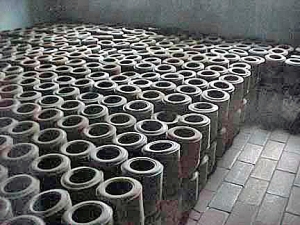I am currently reading a new book entitled The Beasts of Buchenwald written by Flint Whitlock, which has just been published. You can read about the book here. A lot of research has gone into this book and it has lots of good information and rare photos. The author reveals the real name of Ilse Koch’s son, who was conceived while she was a prisoner at Dachau, awaiting trial by the American Military Tribunal. He also reveals the name of the alleged father of her son. I’m not going to tell you the names. Get your own copy and read it yourself.
One thing that caught my attention in the book was this sentence on page 263:
Martin Sommer: The sadistic warden of the Bunker at KL Buchenwald volunteered for combat duty.
Martin Sommer was put on trial by Dr. Georg Konrad Morgen, an SS judge, in 1943. I always thought that Sommer was sent to the Eastern front as punishment for his crimes at Buchenwald. It seems really strange that Martin Sommer was not punished for his horrific crimes.
I previously blogged about Martin Sommer here.
Here is a quote from Wikipedia about Martin Sommer:
In 1943 Reichsführer Heinrich Himmler appointed SS judge Dr. Georg Konrad Morgen to investigate charges of cruelty and corruption at the Buchenwald camp. Due to his excessive brutality and sadism, Sommer was indicted and tried before Morgen. Commandant Karl Koch and his wife Ilse Koch were also put on trial.
According to Morgen, Sommer had a secret compartment underneath the floor under his desk. He kept his private instruments of torture concealed within this compartment such as the needles he used to kill his victims after he was done torturing them, he would inject them with carbolic acid, or inject air into their veins causing their death by embolism. On occasions, after private late night torture sessions Sommer would hide his victim’s bodies under his bed until he could dispose of them in the morning.
Among his acts of depravity were beating a German pastor, hanging him naked outside in the winter then throwing buckets of water on him and letting him freeze to death. On another occasion Sommer beat a Catholic priest to death for performing the Sacrament of Penance for a fellow inmate.
With all this evidence against Martin Sommer, as told by Dr. Morgen himself, why wasn’t Sommer executed like Karl Otto Koch? Whether he was sent to the Eastern front or volunteered, it doesn’t matter. The question is Why did he get off so lightly after killing prisoners so cruelly?
Dr. Morgen put 5 of the concentration camp Commandants on trial in his court and sentenced 2 of them to be executed. Yet he let Martin Sommer off with no punishment at all.
Harry Stein wrote a book entitled Gedenkstätte Buchenwald which was sold at the Buchenwald Memorial Site when I visited in 1999. Stein wrote that Martin Sommer was arrested in connection with the proceedings against Karl Otto Koch, but that Sommer “was not sentenced.” If he was “not sentenced” but went to the Eastern front in 1943, this indicates that he volunteered and was not forced to go.
But why was Martin Sommer not sentenced in Dr. Morgen’s court? His crimes were far more horrible than the crimes of Koch and he had killed more people than Koch, who was only charged with ordering the deaths of two people. Koch did not personally kill anyone, but Martin Sommer had allegedly killed hundreds of prisoners with his own hands. Heinrich Himmler, the man who authorized the trial of Koch, had given an order that the SS men were forbidden “to lay violent hands” on the prisoners. Among Sommer’s alleged crimes was the charge that he had personally crucified two Catholic priests upside down. How did he get by with this, without being sentenced?
The only reason that I can think of is that Karl Otto Koch enriched himself by stealing from the prisoners. That money belonged to the Reich. Martin Sommer didn’t get rich off of killing prisoners in the bunker, so his crimes were not so serious in the eyes of Himmler. Frau Koch had her own bank account, which was suspicious, but that was not enough evidence for Dr. Morgen to convict her. Ilse Koch was acquitted in Dr. Morgen’s court.
Martin Sommer was finally convicted in a German court in 1958. You can read about it in a New York Times article here.
After the war, Dr. Morgen was put into the Bunker at Dachau because he was a “war criminal” as far as the Americans were concerned. He had a chance to hobnob with some of the SS men that he had prosecuted in his court and to learn what it feels like to be a prisoner in a Bunker in a concentration camp.
Dr. Morgen was a member of the SS, which had been designated as a criminal organization by the Allies, so that automatically made him a “war criminal.” Besides that, anyone who had any connection whatsoever to a concentration camp came under the new Allied concept of co-responsibility, which was known as the “common design” or “common plan” to commit war crimes. Dr. Morgen was an SS judge who investigated the camps for criminal activity, so he had a connection to the concentration camps and was thus a war criminal.
Dr. Morgen told historian John Toland that he was beaten several times in an attempt to get him to say that Ilse Koch had personally selected the victims whose tattooed skin was made into lampshades for her home, but he refused.
Flint Whitlock’s new book includes lots of quotes, from the testimony given in 1947 at the American Military Tribunal by Buchenwald survivors, that Ilse Koch did, in fact, have prisoners killed for their tattoos.

























